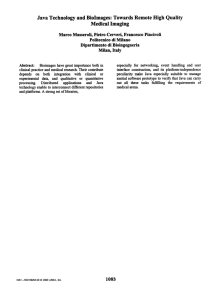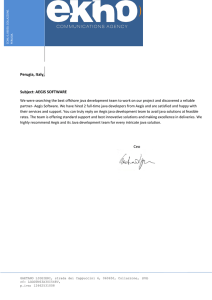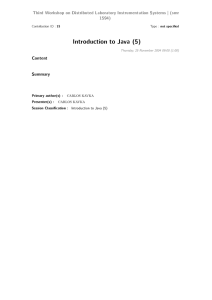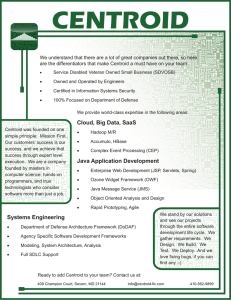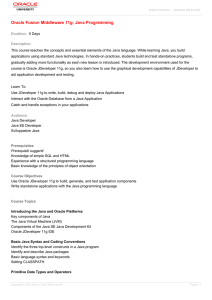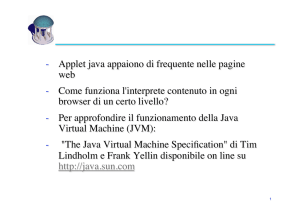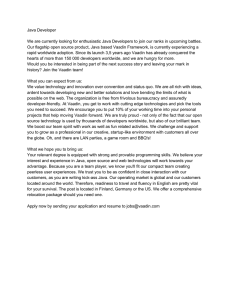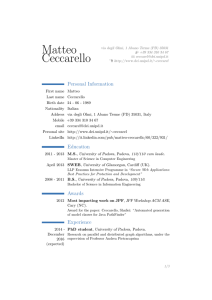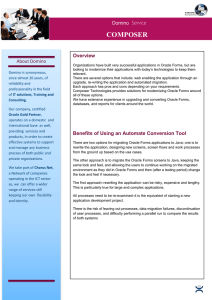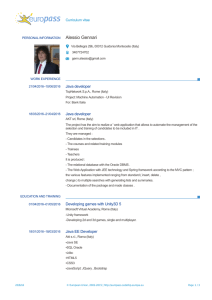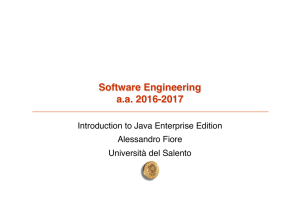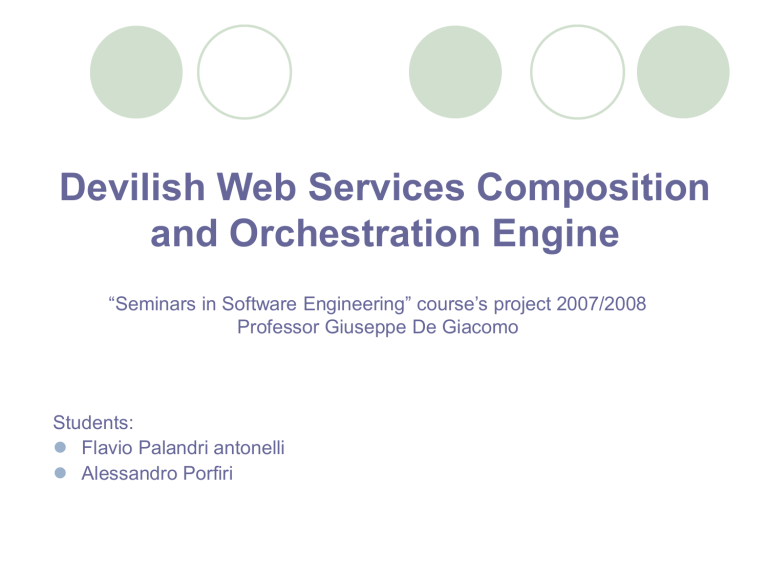
Devilish Web Services Composition
and Orchestration Engine
“Seminars in Software Engineering” course’s project 2007/2008
Professor Giuseppe De Giacomo
Students:
Flavio Palandri antonelli
Alessandro Porfiri
Web Services
Software modules designed to support interaction between heterogeneous
systems in a network or in internet
public interface description of available operation
Standard communication protocols
Interaction via standard messages
Great diffusion of Web Services systems
Many functionalities already implemented and available
Scenario – Web Services Composition
A client requires a TARGET service to be implemented
All functionalities are already implemented in other AVAILABLE SERVICES
Idea: we could realize the TARGET service combining Availables
Service 1
mapping
Service 2
Service request
Client
Community
mapping
Service n
mapping
Objectives
Analyzing Services Composition Problem from a theoretical point of
view
Studying Web Services technologies
Understanding tools already implemented to build automatically the
composition
WSCE
TLV
Development of a tool able to manage the whole process
Build Composition
Generate and publish Target Service
Manage the orchestration of services
Abstract services rapresentation
We need to abstract from service implementation
We rapresent only the service behavior
TRANSTION SYSTEM
Composition actors
Available Services
Existing services
Rapresented by TS
We will consider also non deterministic behavior
Target
Is the service requested by the client
Rapresented by TS
Only deterministic
Orchestrator
The composition manager
Composition
Who is orchestrator?
Build composition
1.Enconding the condition:
in a PDL formula and checking its satisfability
2.Via Simulation
Can we reproduce Target’s behavior with any one
Available Services combination?
Simulation – The Community
Simulation Relation
Simulation Algorithm
Composition via simulation
Composition via simulation
Composition exists iff Simulation exists
OG the Orchestrator Generator
Non deterministic behavior
Simulation with nondeterminism
OG with nondeterminism
TLV A tool for computing composition
Temporal Logic Verifier
LTL based
Computes composition via simulation indirectly
Automatically computes the OG if realizable
Target +
Community
Comp-inv.pf
Synth-inv.tlv
TLV
OG
or
“unrealizable”
TLV / 2
Target +
Community
file smw
TLV / 3
Simulation
constraints:
TLV /4
If composition is realizable TLV’s output is the OG
How to create smw file?
WSCE (web service composition engine) it’s like a wrapper for TLV
Creates smw file from target and available services TS descriptions
Execute TLV on smw file
From TLV result produce sql script to store the OG table into a DB
WSCE
TS descriptions
WSTSL
OG table
TLV
Script sql
WSCE /1 - Input
TS of target and services are described with the xml language WSTSL
WSCE /2 - Output
OG Table – one for each composition case
STATE
IN_ACT
TargetState
State_S1
State_S2
State_S3
OUT_ACT
S1
Login
0
0
0
0
1
S2
searchByAuthor
1
1
0
0
2
S3
searchByTitle
1
1
0
0
3
S4
Listen
2
1
1
0
2
S5
Listen
2
1
0
1
3
Given in_act, Tstate and Si_states
WSCE produce also NEXTSTATE[source, target] table
Now, we just need to develop a tool able to manage the orchestration using
this table
DIGRESSION – WS technologies
Web services are software systems offering operations to remote clients
Available operations are described through the service interface WSDL
Clients communicate with service via SOAP messages on HTTP protocol
Example of a Java Web Service
public class Login {
int stato = 0; boolean loggedin;
public String doLogin(String user)throws Exception{
if(stato != 0){
throw new Exception(“Illegal operation");
}
stato = 1; loggedin = true;
return “User logged in”;
}
public String doLogout(String user)throws Exception{
if(stato != 1){
throw new Exception(“Illegal operation");
}
stato = 0; loggedin = false;
return “User logged out”;
}
login
0
1
logout
}
DIGRESSION - Axis
Axis is a open source tool for
publishing web services (in this way software modules become WS)
Managing clients interaction with WS (request/response)
It runs in a web container (Tomcat)
To publish a service Axis needs Class files and the service’s descriptor file WSDD
<deployment
xmlns="http://xml.apache.org/axis/wsdd/"
xmlns:java="http://xml.apache.org/axis/wsdd/providers/java">
<service name="urn:Login" provider="java:RPC">
<parameter name="className" value=“servicePackage.Login"/>
<parameter name="allowedMethods" value="doLogin, doLogout"/>
<parameter name="scope" value="Session"/>
</service>
</deployment>
Publishing using command “java adminClient login.wsdd”
Service name
Service class
Service methods
Conversation:
Session = stateful
Request = stateless
Application = singleton
DIGRESSION – Service Interface
Publishing the service, axis produce the service interface WSDL with all
informations of service needed by clients
Service name and address
Methods
Output parameter
Input parameters
ComplexType (any non standard Object managed by the service, example Person,
Product, Order...)
WSDL are always accessible, to build the WS Target we will need all Available
Services WSDL.
Our part in this project
We want to complete the whole composition and orchestration process,
developing missing elements
Orchestrator: a tool able to manage requests from Target Service, finding and
delegating the operation to the right Available Service, using informations stored in
the OG Table produced by WSCE. Basically Target will demand all client requests
to the orchestrator
TargetGenerator: a direct extension of WSCE, reading OG and Available Service
WSDL produces and publishes the Target Web Service on Axis
Orchestrator /1 General Scenario
Implementation of orchestrator program P(h,a) = i, and even more
Client invokes Target operation
Target demands client operation request to the orchestrator
The Orchestrator access OG Table to find the index of the Available Service
able to resolve the operation
The Orchestrator invoke the operation to selected service
Result is returned to client through Target Service.
To get the index of available service from the OG, the orchestrator needs:
Requested action
Target state
All Available Services states
Orchestrator /3 Services states
Is orchestrator able to retrieve the status of services?
Target State: Yes always
Target is deterministic
Orchestrator can get Target initial state from OG Table
At each step the orchestrator can get the new TargetState given “Input Action”
and “Orchestrator State” using the NEXTSTATE table
Available Services states: depends
Deterministic: yes it could easily retrieve it from the OG Table
Non deterministic: No, orchestrator must query all AS to retrieve their status
Available Services have to manage their status
They must offer a “int getStatus()” remote operation
Connection with between Orchestrator and all services must be stateful
Orchestrator /2 Architecture
- Unique component for every target (reuse)
- An instance of orchestrator for each target
- Orchestrator must be able to manage requests from Concurrent Clients
Orchestrator /4 Composition infos
Orchestrator is indipendent from composition case
The component must be usable from any target
Target has to initialize his own orchestrator with composition infos:
Name of OG table
List of avalable service
Service index
Service name
Service address
Complex type classes list
Orchestrator /5 Initialization
Orchestrator Initialization:
Receives all informations from Target
For each Available Service establish a stateful connection: Call, mantained
during the whole conversation with that client
Registers all ComplexType’s classes
Operation invocation
Using Calls to retrieve states from services
Using Call to invoke operation to selected service
Orchestrator /6 Concurrency
Each Client has a Session with an instance of WS target
Each Target has instance of orchestrator
Each Orchestrator has a Session with every available services.
This way Concurrency
is guaranteed
Orchestrator /7 OP invocation
Initialization: only for
the first invocation
Operation invocation
Orchestrator /8 Implementation
Orchestrator /9 Distribution
Distributed as library
Targets generated automatically are already made to use this library
User can also build manually their own Target using Orchestrator’s API
Target Generator /1
How do we build the Target Service?
• User can make the java class, publishing it manually
• User can use the TargetGenerator to build it in 1 minute
INPUT
• OG script provided by WSCE
• WSDL files one for each available service
OUTPUT
• Target web service published on Axis ready to receive
requests
• OG Table stored in Mysql DB
Target Generator /2 Operations
To register a service Axis needs class file of target service, wsdd file, class files of
ComplexType
Creates java file of target and complextypes (ex person, product)
Compiles all files
Creates wsdd of target
Publishes target service on Axis using “AdminClient”
Target Generator /3 The whole process
Target Generator /4 Class Schema
Target must import orchestrator.jar
Class header, class name is taken from input
Global variable of the Orchestrator
Constructor
Prepare all informations needed for composition
OG tablename
Array of ServiceInfo (name, address) //index is cabled in the array structure
List of ComplexTypes’ classes
Orchestrator = new Orchestrator(tablename, serviceInfos, complexTypes)
Sequence of dummy methods representing remote operations of Service
Method header
Output parameter
Input parameters
Operation demanded to orchestrator, orchestrator.invoke(op)
Result returned to client
Target Generator /5 Architecture
All informations needed are retrieved from WSDL files
of Available Services using WSDLParser
Target Generator /6 Execution flow
Target Generator /7 init Data
Target Generator parses
WSDL of Available
Services to retrieve
composition infos
Services name, address
ComplexTypes
Methods
Running Tools
Example 1 – Test1ND: a Web Service to
listen songs
Example 2 – MediaStore: tipical ECommerce application with interactive
client
Other example can be found on the documentation
Example – Test1ND
TS
Example – Test1ND
Example of WSTSL
SearchByAuthorND.wstsl
<?xml version="1.0" encoding="UTF-8"?>
<TS
xmlns='http://www.dis.uniroma1.it/WS-TSL'
xmlns:xsi='http://www.w3.org/2001/XMLSchema-instance'
xsi:schemaLocation='http://www.dis.uniroma1.it/WS-TSL file:/D:/sviluppo SW/FSMJ5Updated/FSM/ts.xsd'
service="SearchByAuthorND">
<STATE name="S0" tipology="initial-final">
<TRANSITION action="SearchByAuthor">
<TARGET state="S1"></TARGET>
<TARGET state="S0"></TARGET>
</TRANSITION>
</STATE>
<STATE name="S1" tipology="transient">
<TRANSITION action="Listen">
<TARGET state="S0"></TARGET>
</TRANSITION>
</STATE>
</TS>
Example – Test1ND
Java file of service
package test1NDCommunity;
public class SearchByAuthorND{
int stato = 0;
public String SearchByAuthor(String author) throws Exception{
if(stato != 0){
throw new Exception("Service is not able to execute this operation in this state");
}
String canzone = "";
if(!author.equals("Paul")){
stato = 1;
canzone = "yesterday";
}
else{
//ND the service doesn't work with input Paul, keep state 0
canzone = "NOT FOUND";
}
return canzone;
}
public String Listen(String name)throws Exception{
if(stato != 1){
throw new Exception("Service is not able to execute this operation in this state");
}
stato = 0;
return name+"...yesterday, all my troubles seems so far away...";
}
public int getStatus(){
return stato;
}
}
Example – Test1ND
Example of WSDD
SearchByAuthorND.wsdd
<deployment
xmlns="http://xml.apache.org/axis/wsdd/"
xmlns:java="http://xml.apache.org/axis/wsdd/providers/java">
<service name="urn:SearchByAuthorND" provider="java:RPC">
<parameter name="className" value="test1NDCommunity.SearchByAuthorND"/>
<parameter name="allowedMethods" value="SearchByAuthor, Listen, getStatus"/>
<parameter name="scope" value="Session"/>
</service>
</deployment>
Example – Test1ND
After published all service
User has to download WSDL of Available Service to prepare the
wsdl directory
1 Execute WSCE
C:\wsce-lite-dist_0.1>java -jar wsce.jar test1ND
2 Generate target
C:\wsce-lite-dist_0.1>java -jar targetgenerator.jar test1nd
3 Execute client
C:\wsce-lite-dist_0.1\Composizioni\test1ND\services\ClientTest1ND.java
Example – MediaStore
Another example - TS
Example – MediaStore
Example of WSTL
CartManagement.wstsl
<?xml version="1.0" encoding="UTF-8"?>
<TS
xmlns='http://www.dis.uniroma1.it/WS-TSL'
xmlns:xsi='http://www.w3.org/2001/XMLSchema-instance'
xsi:schemaLocation='http://www.dis.uniroma1.it/WS-TSL file:/D:/sviluppo SW/FSMJ5Updated/FSM/ts.xsd'
service="CartManagement">
<STATE name="S0" tipology="initial-final">
<TRANSITION action="addToCart">
<TARGET state="S0"></TARGET>
</TRANSITION>
<TRANSITION action="viewCart">
<TARGET state="S1"></TARGET>
</TRANSITION>
</STATE>
<STATE name="S1" tipology="final">
<TRANSITION action="removeFromCart">
<TARGET state="S1"></TARGET>
</TRANSITION>
<TRANSITION action="addToCart">
<TARGET state="S1"></TARGET>
</TRANSITION>
<TRANSITION action="viewCart">
<TARGET state="S1"></TARGET>
</TRANSITION>
</STATE>
</TS>
Example – MediaStore
Example of WSDD with complex type
CartManagement.wsdd
<deployment
xmlns="http://xml.apache.org/axis/wsdd/"
xmlns:java="http://xml.apache.org/axis/wsdd/providers/java">
<service name="urn:CartManagement" provider="java:RPC">
<parameter name="className" value="mediaStoreCommunity.CartManagement"/>
<parameter name="allowedMethods" value="viewCart, addToCart, removeFromCart, getStatus"/>
<parameter name="scope" value="Session"/>
<beanMapping qname="myNS:Product" xmlns:myNS="urn:CartManagement" languageSpecificType="java:mediaStoreCommunity.Product"/>
</service>
</deployment>
Example – MediaStore
Java file of an Available Service
CartManagement.java
package mediaStoreCommunity;
import java.util.*;
public class CartManagement {
private int state = 0;
private Vector cart;
public CartManagement() {
cart = new Vector();
}
public Vector viewCart(){
state = 1;
return cart;
}
public Product addToCart(Product p){
cart.add(p);
return p;
}
public void removeFromCart(Product p) throws Exception{
if(state!=1){
throw new Exception("Invalid operation request for this state");
}
Iterator it = cart.iterator();
while(it.hasNext()){
Product p2 = (Product)it.next();
if(p2.getCode() == p.getCode())
it.remove();
}
}
public int getStatus(){
return state;
}
}
Example – MediaStore
Java file of complex type
Product.java
package mediaStoreCommunity;
import java.io.*;
public class Product implements Serializable{
private
private
private
private
int code;
String name;
String type;
double price;
public Product(){
}
public int getCode(){
return code;
}
public void setCode(int c){
code = c;
}
//set e get di tutti i metodi
}
Example – MediaStore
After published all service
java org.apache.axis.client.AdminClient <file>.wsdd
1 Execute WSCE
C:\wsce-lite-dist_0.1>java -jar wsce.jar MediaStore
2 Generate target
C:\wsce-lite-dist_0.1>java -jar targetgenerator.jar MediaStore
3 Execute client
C:\wsce-lite-dist_0.1\Composizioni\MediaStore\services\ClientMediaStore.java
MediaStore.java
Example – MediaStore
package MediaStore;
import orchestrator.*;
import javax.xml.rpc.ServiceException;
import java.util.*;
public class MediaStore {
private Orchestrator orchestrator;private String tablename;
public MediaStore() throws Exception{
tablename = "MediaStore";
ServiceInfo[] services = new ServiceInfo[4];
services[0] = new ServiceInfo("http://127.0.0.1:8080/axis/services/", "urn:CartManagement");
services[1] = new ServiceInfo("http://127.0.0.1:8080/axis/services/", "urn:ProductList");
services[2] = new ServiceInfo("http://127.0.0.1:8080/axis/services/", "urn:CheckOutService");
services[3] = new ServiceInfo("http://127.0.0.1:8080/axis/services/", "urn:BuyService");
LinkedList<Class> complexTypes = new LinkedList<Class>();
complexTypes.add(Product.class);
orchestrator = new Orchestrator(services, tablename, complexTypes);
}
public Product addToCart(Product in0)throws Exception{
Object[] params = {in0};
Object risposta = orchestrator.invokeOperation("addToCart", params);
return (Product)risposta;
}
public java.util.Vector viewCart()throws Exception{
Object[] params = {};
Object risposta = orchestrator.invokeOperation("viewCart", params);
return (java.util.Vector)risposta;
}
public void removeFromCart(Product in0)throws Exception{
Object[] params = {in0};
Object risposta = orchestrator.invokeOperation("removeFromCart", params);
}
public java.util.Vector getProductList()throws Exception{
Object[] params = {};
Object risposta = orchestrator.invokeOperation("getProductList", params);
return (java.util.Vector)risposta;
}
public String buy(double in0)throws Exception{
Object[] params = {in0};
Object risposta = orchestrator.invokeOperation("buy", params);
return (String)risposta;
}
public double checkOut(java.util.Vector in0)throws Exception{
Object[] params = {in0};
Object risposta = orchestrator.invokeOperation("checkOut", params);
return (Double)risposta;
}
public int getStatus(){ return orchestrator.getTargetState(); }
Target created
}
Conclusions
Users can build their Target Service in 5 minutes componing existing services
Build Target manually using orchestrator’s API
Build Target automatically
ComplexTypes are managed
The whole orchestration process is now completely working
Client concurrency
Target itself may be an Available Service for another case of Composition
Problems
Available Services have to manage their state and offer the getStatus
operation
We could spread in internet a “Componible” interface to be implemented
Extensions
Intergration of WSCE and TargetGenerator
The tool should be accessible remotely, with user friendly interface
Extension to RMI services

